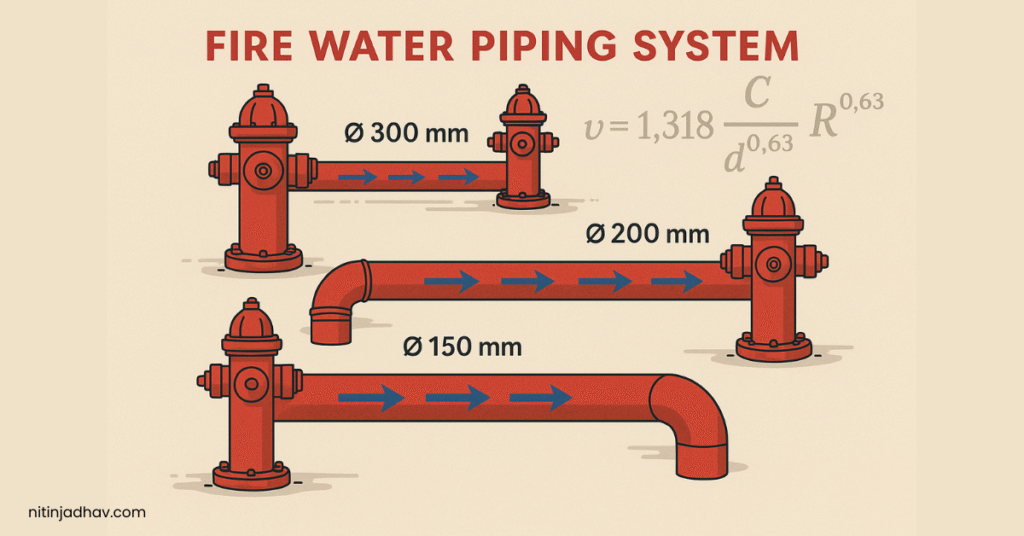🔍 Introduction
In fire protection systems, pipe sizing is a critical design step that ensures water is delivered at the required flow and pressure during an emergency. Whether you’re working on a hydrant system, sprinkler network, or foam-based protection line, selecting the right pipe size is essential for both compliance and performance.
In this article, you’ll learn:
- Why pipe sizing matters in fire water systems
- The standard formula for pipe diameter
- Reference flow velocities as per NFPA/OISD
- Manual calculation with example
- Use of a free online calculator
- FAQs for on-site engineers
🧠 Why Accurate Pipe Sizing Matters
Improper sizing can lead to:
- Insufficient flow or pressure at hydrants/nozzles
- Excessive pressure drop over long distances
- Higher capital and operating costs
- Non-compliance with NFPA, OISD, or IS fire codes
Correct pipe sizing ensures:
✅ Reliable flow during a fire emergency
✅ Minimal friction loss
✅ Lower chance of erosion or noise
✅ Cost-effective system design
📐 Formula for Pipe Size Calculation
The basic formula used in hydraulics to find pipe diameter is: Q=A×VQ = A \times VQ=A×V A=QV⇒D=4QπVA = \frac{Q}{V} \quad \Rightarrow \quad D = \sqrt{\frac{4Q}{\pi V}}A=VQ⇒D=πV4Q
Where:
- Q = Flow rate (m³/s)
- V = Flow velocity (m/s)
- D = Internal pipe diameter (m)
- A = Cross-sectional area (m²)
⚖️ Standard Velocity Guidelines (NFPA / OISD)
| Pipe Type | Recommended Velocity |
|---|---|
| Hydrant Lines | 3.0 – 5.0 m/s |
| Sprinkler Mains | 2.0 – 3.0 m/s |
| Foam Lines | Max. 5.0 m/s |
| Pump Suction Lines | 1.5 – 2.5 m/s |
🔎 Tip: Keep friction losses below 1 bar/km to avoid performance loss over long distances.
🧮 Manual Example: Pipe Size for Hydrant Line
Given:
- Flow Rate = 720 m³/hr
- Velocity = 3.5 m/s
Step 1: Convert flow rate to m³/s Q=7203600=0.2 m³/sQ = \frac{720}{3600} = 0.2 \, \text{m³/s}Q=3600720=0.2m³/s
Step 2: Calculate Diameter D=4×0.2π×3.5≈0.27 m=270 mmD = \sqrt{\frac{4 \times 0.2}{\pi \times 3.5}} \approx 0.27 \, \text{m} = 270 \, \text{mm}D=π×3.54×0.2≈0.27m=270mm
Answer: Use 300 NB commercial pipe
🔧 Use Our Fire Water Pipe Size Calculator (Instant)
To automate the above calculation, use our free online calculator below:
👉 Adjust the flow rate and velocity values to get accurate pipe diameter and area instantly.
Pipe Flow Calculator
Enter Velocity and Flow Rate to see pipe details
| Cross-Sectional Area | 0.00 mm² |
| Pipe Diameter (mm) | 0.00 mm |
| Pipe Diameter (in) | 0.00 in |
📏 Pipe Size Reference Table (NB vs Diameter)
| Nominal Bore (NB) | Approx. ID (mm) | Cross-Section Area (mm²) |
|---|---|---|
| 100 NB | ~102 mm | 8,171 mm² |
| 150 NB | ~154 mm | 18,602 mm² |
| 200 NB | ~202 mm | 32,042 mm² |
| 250 NB | ~254 mm | 50,686 mm² |
| 300 NB | ~303 mm | 72,105 mm² |
| 350 NB | ~353 mm | 97,870 mm² |
🛠️ Engineering Tips for Pipe Sizing
- Use internal diameter in formulas, not outer diameter
- Keep water velocity below 5 m/s in carbon steel pipes
- For large networks, simulate using software like PipeFlow Expert, WaterGEMS, or AutoPIPE
- Always cross-check with design codes: OISD-117, NFPA-24, IS 3034
❓ FAQs – Pipe Size Calculation
Q1: What’s the maximum allowed velocity in fire lines?
Ideally, < 5.0 m/s to avoid erosion and pressure spikes.
Q2: How do I convert pipe size from mm to inches?
Use the calculator. Divide mm by 25.4 to get inches.
Q3: Should I consider friction loss while sizing?
Yes. Use Darcy-Weisbach or Hazen-Williams method to validate head loss.
Q4: Can I use 100 NB pipe for hydrant?
No. Minimum standard for hydrant loop is 150 NB, preferably 200 NB.


